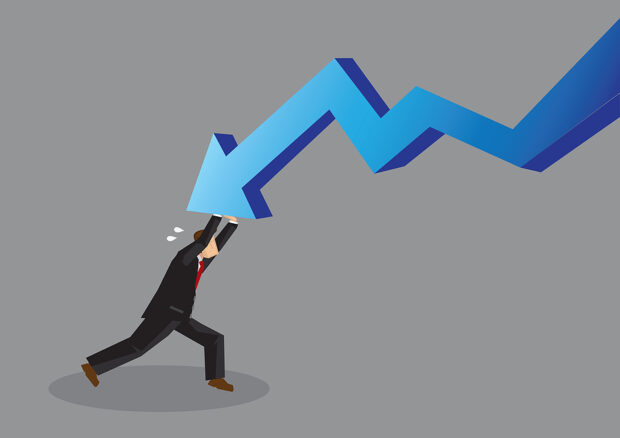Even though direct written premiums for U.S. personal auto insurers soared by double-digits and economic inflation has eased, personal lines underwriting results did not turn around during the first half of 2023, AM Best reports.
In fact, according to a chart included in the Best’s Market Segment Report, “U.S. Personal Auto Results Worsen as Claims Severity Rises,” the industrywide direct loss ratio for U.S. private passenger auto liability for the first half of 2023 actually rose 3.6 points to 75.6 over the 72.0 ratio recorded for first-half 2022. Similarly, the auto physical damage ratio, coming in at 76.0 in 2023 for the first six months, was 3.8 points above the 72.2 level AM Best calculated for the same period in 2022.
“In the numbers through midyear, we really haven’t seen the improvement that we would like to talk about for the overall private passenger auto industry,” AM Best Associate Director David Blades said on a video posted on the AM Best website highlighting some key takeaways from the report published yesterday.
Blades authored an article for Carrier Management earlier this year titled “U.S. Personal Auto Results Headed the Wrong Way. Is a U-Turn Possible,” noting that the persistence of high loss costs made the prospect of a return to underwriting profitability for the auto segment highly unlikely in 2023.
“We may see that over time or [even] in the near future. But right now through midyear, we haven’t seen a great turnaround in terms of the results” in spite of all that carriers have done to push for rate adequacy, Blades said.
Noting that the industry combined ratio was 112.2 in 2022, Christopher Graham, senior industry analyst and co-author of the latest market segment report, noted that even if there had been no increase in loss costs this year, carriers would “still need double-digit rate increases just to get to [the] level of being able to break even.”
“And there’s a long regulatory process to get through… It’s not going to be easy, and you’re still going to have some increase in the loss costs no matter what,” he said.
Both Blades and Graham said that loss costs have continued rising but the trend is no longer tied to economic inflation, which was an ingredient in the “perfect storm” that pushed the 2022 industry combined ratio up more than 10 points over 2021. Instead, the two analysts attributed claims severity increases to riskier driving habits, driver inattentiveness and social inflation.
Blades highlighted the fact that changing workplace patterns—businesses allowing people to work from home—have actually meant there are now fewer cars on the road. But those drivers that are out on the roads are driving at higher rates of speed, resulting in more serious accidents when crashes happen, he said, pointing to governmental studies supporting this.
Graham noted that economic inflation is easing, “but that doesn’t account for social inflation,” which has been a big driver in loss increases in commercial auto in the past. “Now, it looks like it’s creeping into personal auto,” he said.
Picking up on what Blades said about a trend toward more severe accidents, Graham noted that even though accident frequency actually fell below pre-pandemic levels in 2022, auto accident “fatalities are way up. [And] when you get more severe accidents, you get more legal participation from the plaintiffs [bar]. So, that’s going to push for more social inflation. That’s not going to go away,” he said. “You’re not going to see losses come down.”
Still, all hope is not lost, Blades suggested during the video, noting that carriers who drill down into their portfolios to determine whether the issues they are facing are jurisdictional or national and also seek to identify where they need to sharpen risk selection and tighten underwriting will be better able to chip away at unfavorable results. Blades also said that investments in technology-driven data analytics to help with risk selection, underwriting and claims handling are separating the carriers who are able to combat the negative severity trends from those that will continue to see their underwriting results impacted by those trends.
AM Best expects the accelerated pace of technology adoption to continue, the market segment report said.
The written report also includes a list of the top 20 U.S. private passenger auto writers ranked by first-half 2023 direct premiums, displaying both premium growth since first-half 2022 and incurred loss ratios for both half-year periods.
The first-half loss ratios range from a high of 103 for Kemper to a low 61.7 for Sentry Insurance Group.
While Kemper and Sentry are among the smallest companies among the top 20 (Kemper ranked No. 15 and Sentry No. 19 based on direct first-half premiums), some of the largest insurers also reported high loss ratios in 2023.
The largest insurer, State Farm, reported the second highest loss ratio, although the 85.9 figure for the first-half of 2023 was a full 17 points below Kemper’s result. According to AM Best, State Farm’s first-half 2023 incurred loss ratio was also slightly better than State Farm’s first-half 2022 loss ratio (87.7)
The AM Best chart reveals that GEICO, the third-largest personal auto insurer, recorded the most improved loss ratio result, with its 77.0 loss ratio down 7.5 points compared to first-half 2022 (84.5)
The Hartford experienced the second-biggest deterioration in its loss ratio behind Kemper. Kemper’s loss ratio worsened 27.9 points to over 100; The Hartford’s loss ratio deteriorated 21.3 points to 82.6 for first-half 2023, compared to 61.3 for first-half 2022.





















 New York Times Sues Perplexity AI for ‘Illegal’ Copying of Content
New York Times Sues Perplexity AI for ‘Illegal’ Copying of Content  Demystifying the Data Landscape: Lake, Warehouse and Lakehouse Explained
Demystifying the Data Landscape: Lake, Warehouse and Lakehouse Explained  U.S. E&S Outlook No Longer Positive: AM Best
U.S. E&S Outlook No Longer Positive: AM Best  Executive Utterances: On Presenting
Executive Utterances: On Presenting 







